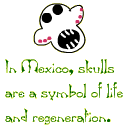
|

|
 |
|
|
When Monarch butterflies return to Mexico, they are believed to bring the spirits of the dead...the spirits to be honored during Los Dias de los Muertos--DAYS OF THE DEAD. This traditional Mexico holiday honors the dead, about the same time as others celebrate Halloween.
Los Dias de los Muertos is not a sad time, but instead a time of remembering and rejoicing.
The tradition of El dias de los muertos has its roots in pre-Hispanic America.In Mexico, the festivities of the cult of the dead
dates back to 1800 BC. Day of the Dead is a happy family event to remember
ancestors. They believe the spirits visit the earth once a year. This
concept of the cycle or circle of life is a strong tradition with many
native peoples worldwide.
To celebrate, people dress up as ghosts, mummies and
skeletons to parade through town. In homes, families create altars, (ofrendas),
to remember the departed ones, parents and grandparents.
To decorate and leave a fragrance
on the altar, the traditional cempasuchil flower is placed.
Cempasuchil comes from Nahuatl cempoalxochitl, which means the flower
with four hundred lives. The flower petals form a path for the spirits
to bring them to their banquet.
Families travel to a cemetery carrying rakes,
hoes, shovels. flowers, candles, blankets, and picnic baskets. The tools
are to clean the graves of the loved ones. They bring flowers, fruit and
place candles on graves. Families often spend the entire night there.
The candles are to light the way for the dead upon their return.
Skulls and bones are placed there, made of chocolate and marzipan. A bread called pan de muertos is decorated with white chocolate bones.
The Day of the Dead bread, pan de muerto, is served with fruit and candy. Pan de Muerto is plain round sweet bread sprinkled with white sugar bone shape laid on top. Many also add the departed person's favorite food and photograph to the grave or altar. Calacas are everywhere. These handmade skeletons show a happy afterlife.
![]()






